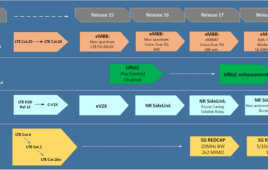As carriers move to next-gen technologies like WiMAX and LTE,
their backhaul needs will grow, prompting them to move from
TDM-based systems to Ethernet over the next decade.
A few years ago, Amir Zoufonoun, by then a 24-year veteran of the microwave industry, thought he was getting out of the industry. Between gigs, he had a year off to look at alternatives. But he was lured back, in part by the incredible growth prospects – better than he’d ever seen in all the years prior. Now he’s president, CEO and co-founder of Exalt Communications, a wireless backhaul solutions provider.
 |
|
Zoufonoun: Expects
transition from TDM-based backhaul to Ethernet to take 8 to 10 years. |
He isn’t the only one. Exalt is attracting other industry veterans, like Michelle Pampin, vice president of marketing and business development, who spent the last 10 years in telecom, most recently with JDSU. Before that, she was at Harris’ Microwave Division, now Harris Stratix Networks. She, too, thought she was getting out of the microwave business, only to be drawn back.
ALL FOR ETHERNET
Proponents of microwave say operators generally have three choices: use leased lines, trench for new fiber or use microwave. What Exalt and others are banking on is operators will find it impossible – cost prohibitive and too time-consuming – to use copper or fiber and microwave will become the No. 1 choice. So far, it seems to be paying off. Worldwide, “we’re not lacking opportunities,” Zoufonoun says.
Much of the excitement around backhaul is tied to the transition from time domain multiplexed (TDM)-based backhaul to Ethernet, or IP-based systems. It’s not a quick transformation – executives like Zoufonoun see it as an 8- to 10-year process. Still, whenever there’s a major transition in a market, new entrants are attracted. “It’s a huge market” – on the order of $5 billion globally, says Emmy Johnson, founder and principal analyst at Sky Light Research. And even though backhaul is attracting new players, it’s a highly specialized industry where you aren’t likely to see a lot of fly-by-nights. “The companies that are in it now do it very well.”
 |
|
Pampin: Lured back
into the market by the market potential. |
One of those long-time specialists is Alcatel-Lucent, which offers its Mobile Evolution Transport Architecture (META) using optical, microwave and other network management products and services to get CDMA and GSM/UMTS operators from TDM to IP. “Backhaul is playing a huge role in operators’ opex and as traffic is increasing, we need to lower the cost of backhaul,” says Andre Mechaly, marketing and communications vice president, mobile access division of Alcatel-Lucent.
That transition to Ethernet is driven largely by data capabilities that 3G, 4G and any future technologies will bring. Without the backhaul, the new speeds and capacities won’t do much good. “It’s kind of like the spine or the main traffic area for all the traffic that goes back and forth, so if your backhaul breaks down, then your network doesn’t work,” Johnson says.
ALL IN GOOD TIME
Most operators are expected to make the switch from TDM to Ethernet, but they aren’t going to do it overnight. “It’s a question of timing,” says Chris O’Loughlin, vice president of sales and marketing at Telecom Transport Management (TTM). Companies like TTM say they can get solutions deployed faster because their solutions are less expensive and easier to deal with than the LECs, which own the majority of the backhaul market. Moves toward more open access environments are only going to accelerate the need for Ethernet, they say.
 |
|
O’Loughlin:
Timing is everything with Ethernet. |
AT&T did not have to do anything special to meet its backhaul needs for HSPA, but it has indicated it eventually will move to an Ethernet strategy. The speed of that development will depend in part on customer demand for services, both in terms of quantity and type of services, says Tom Keathley, vice president of radio access and standards/architecture and planning at AT&T.
Sprint Nextel is using a combination of backhaul solutions for its WiMAX network, depending on what makes the most sense for a given geographic area. One of its vendors is FiberTower, which uses both microwave and fiber technologies.
FiberTower has been talking to carriers about Ethernet for years, but just over a year ago, it started working with Sprint. The vendor went through a lengthy vetting process with the carrier spelling out all the requirements. But once FiberTower gets a project, it’s mainly a matter of executing, much like a construction company does, says Mike Finlayson, senior vice president of technology at FiberTower. “You gotta show you can deliver it and scale the product. Right now, we’re in the middle of that … where together we’re all showing that we can scale this process up.”
 |
|
Ostiguy: Conducts
throughput evaluation to prove service levels |
His recommendation for anyone considering Ethernet is to spend time thinking about the operational aspects and less time worrying about things like latency and jitter. Those are important, but provisioning and maintenance, which might sound mundane, are important too and often overlooked. “You need to realize it’s more than finding a fast pipe,” he says. “It’s finding a fast pipe and somebody who can manage it for you.”
PROVING IT OUT
None of the solutions mean much without someone to make sure they’re delivering what carriers expect. The transition to technologies such as WiMAX are producing the strictest service level agreements (SLAs) ever required, sources say. Monitoring solutions allow Sprint to verify that its backhaul providers are doing their job, and it allows the vendors to prove to carriers they’re living up to terms. “We kind of sell arms to both camps,” says Accedian CEO Patrick Ostiguy. The company says it performs throughput measurements while services are running, so there’s no need for downtime.
JDSU also offers test solutions. “I think the wireless operators have a big challenge to make sure the services they’re getting are the quality of what they’re paying for,” says Andrew Sachs, director of strategy/service assurance at CommTest/T&M at JDSU. “That’s where our tools come into play. It’s a big issue for them. This backhaul is the lifeblood of their business. It’s an extremely critical link and it’s out of their direct control.”
Vendors say most wireless carriers, even those with ties to wireline siblings, want to see more alternatives to backhaul, and backhaul providers are eager to meet their needs. “We pay a lot of attention to our customers, and we’re very hungry and eager to provide them with good service,” says Frank Mastrobattista, co-founder and COO at TTM.




